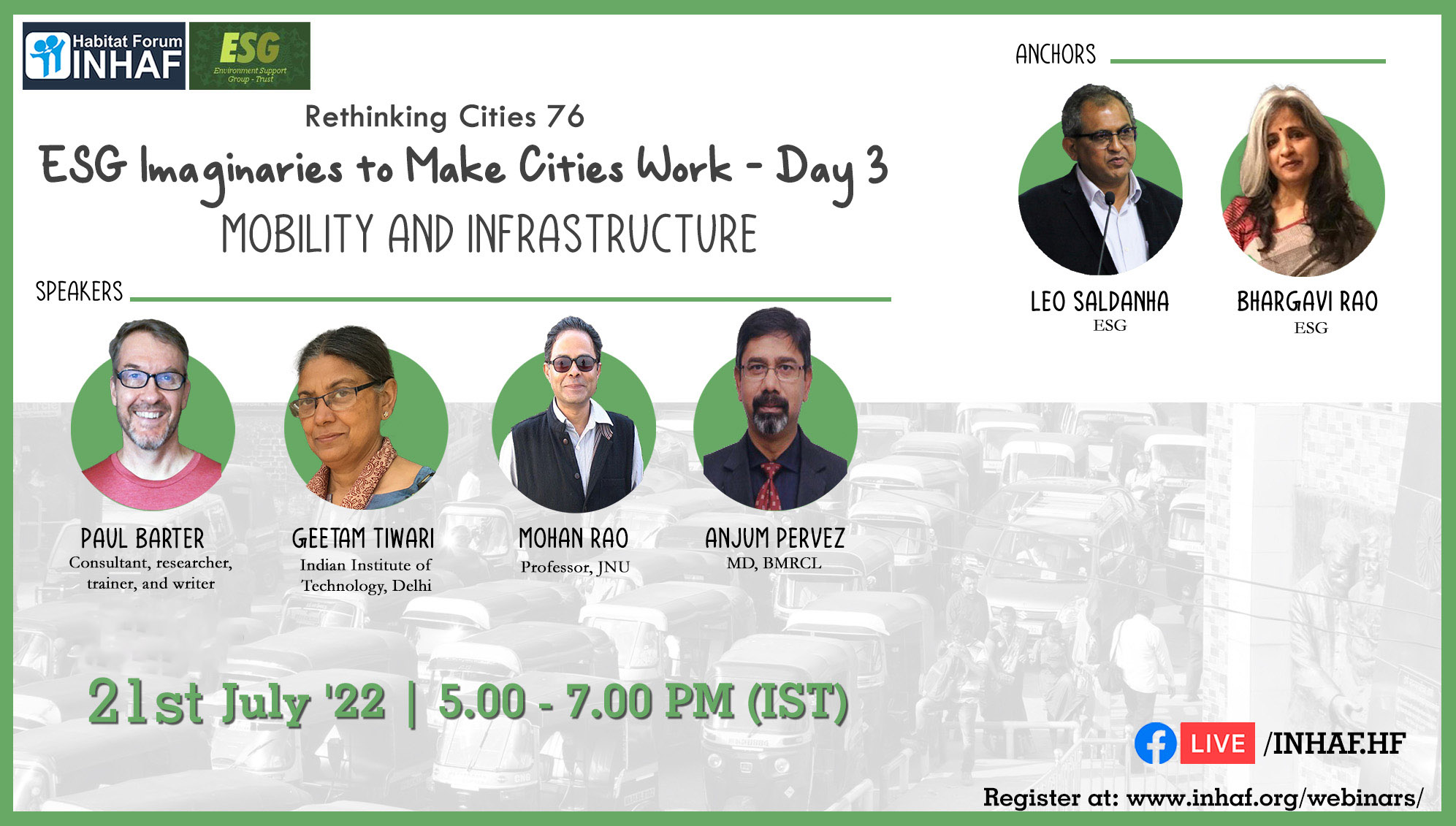
Local Time
- Timezone: America/New_York
- Date: Jul 21 2022
ESG Imaginaries to Make Cities Work – Day 3 : Mobility and Infrastructure
Background:
For over two decades, ESG has focussed on emerging urban environmental and socio-economic challenges and worked with multiple communities, government agencies, academia, media, etc. in attending to these issues and conflicts. The approach has always been about finding viable and inclusive solutions to vexatious problems by advocating deeply democratic processes which draw on intersectoral, interdisciplinary, intersectional experiences, and knowledge and histories. Bangalore and other cities are in a mess today as they follow highly centralised governance approaches which drift away from Constitutional mandates and legal provisions that require decentralisation of administration and devolution of power. As a result various local publics do not find their due place to imagine their futures, which are then collated to build the collective imagining of the city and its future.
In ESG Imaginaries to Make Cities Work, participants drawn from diverse disciplines and sectors would reflect on the sort of issues and concerns that have become systemic to urban governance and living, reflect on the initiatives of ESG in addressing them, and articulate ideas and imaginaries in constructing better futures, and of consequences if we were to not make such efforts.
Mobility and Infrastructure:
Cities are about ease of mobility. The idea works when everyone has access to means of mobility. However, Bangalore is representative of the malaise arrogating power to those who have the means to afford private vehicles, particularly cars. The motorcar designs the city in more ways than one comprehends, and the result is that most urban infrastructure – be it the elevated corridors, Bangalore Mysore Infrastructure Corridor, road widening, expressways to the airport, steel flyover – are all representative of elite driven urbanisms. Resultantly, the State has abrogated its duty to represent all sections of society and typically rushes to please the elite in matters of their mobility. The resultant cost of such infrastructure development is borne by all and the least contribution is from the elite who caused this massive public expenditure, which should rightfully have been invested in social welfare, education, health for all, environmental protection, etc.
Such methods of the elite imagining the city has become endemic to Bangalore’s planning and development and resulted in structural collapse in organic evolution of the city. An urb that was a pleasure to walk and cycle in, has now no place for such mobilities. Instead, the sprawl, an actualisation of policies that financialised land, resulting in elite capture of spaces core to the city or with infrastructure provisioning, has contributed to marginalisation of a majority of the working classes and the poor, and the lower middle classes.
The absolute lack of investment in public transport that is accessible to all has turned survival in the city – for which one needs to be mobile – a tortuous process. The building of the Metro further privileges those with resources to buy into commercial and residential spaces created along the corridor, to ensure it has ridership, whereas those who need an affordable and effective means of public transport, find the system unaffordable. As a consequence, the Metro which was supposed to relieve the metropolis of traffic congestion – with its attendant loss of mobility, increase in air and noise pollution, loss of economic potential, loss of livelihoods, loss of functional street space, and also loss of public revenue, etc. – is now being expanded to cater to those travelling to the airport at enormous public cost which will be borned by displaced farming communities and the hapless commuter who is forced to take to the two wheeler. The public bus system, which carries ten times the commuter load that the metro does, finds no financial support from the State, whatsoever.
In attending to such complex challenges of the metropolis, ESG has worked with street communities to reclaim streets as public commons, to protect street vendor rights, to promote pedestrian and cycling rights, to secure urban greenery – especially tree lines and heritage spaces, all to promote the idea of a city that would ensure inclusivity is central to such public spaces and infrastructure. The argument has been and continues to be that there must be deep democratisation of decision making relating to mobility and infrastructure development so that the promise of Article 39 B – that ownership and employment of material resources best serve the common good – is actually an argument for protecting commons, ensuring good health, promoting environmentally viable and equitable livelihoods, and ensuring the city is a construct that is socially responsible, economically viable and ecologically wise.
These are indicative examples of ESG’s interventions to make cities inclusive and sustainable.
